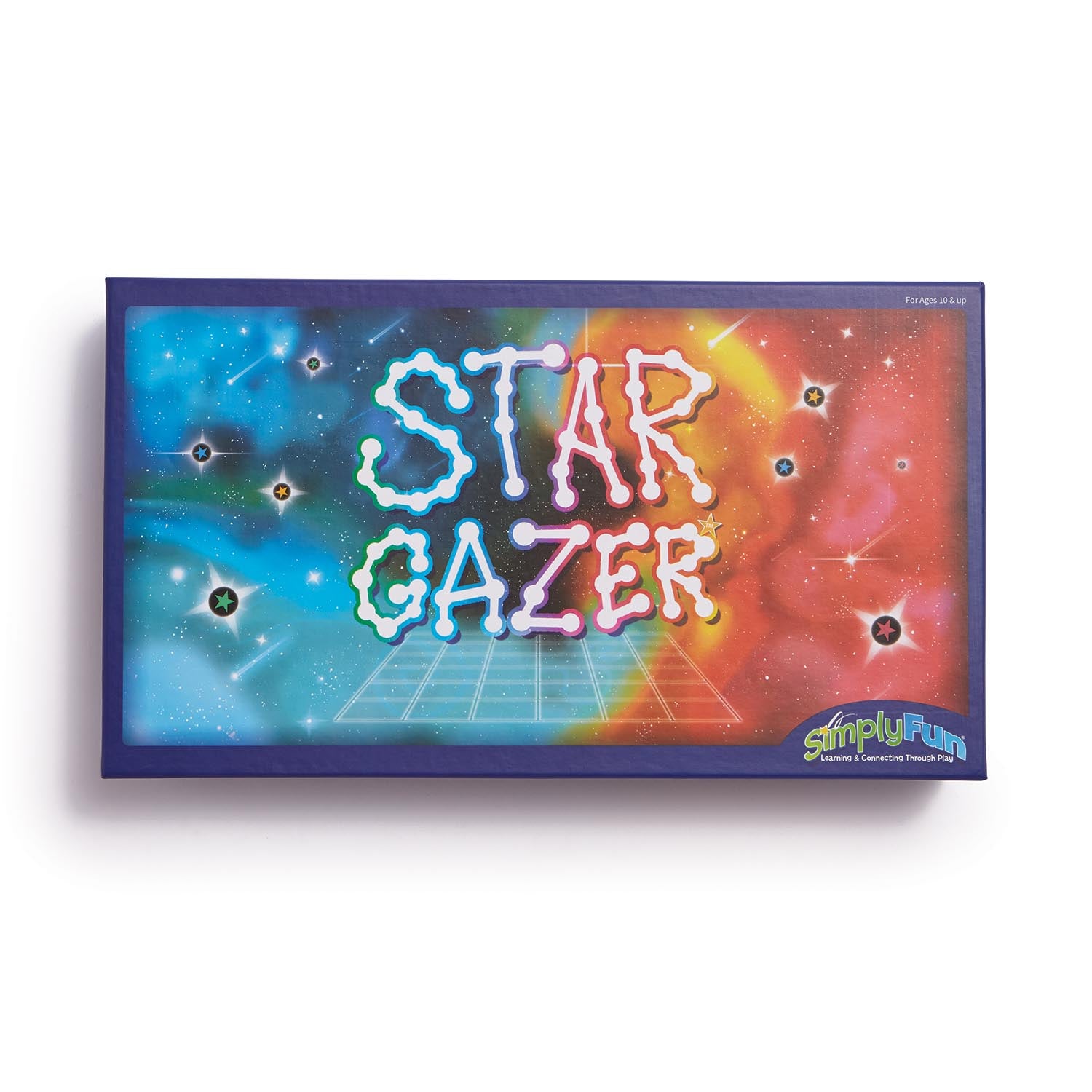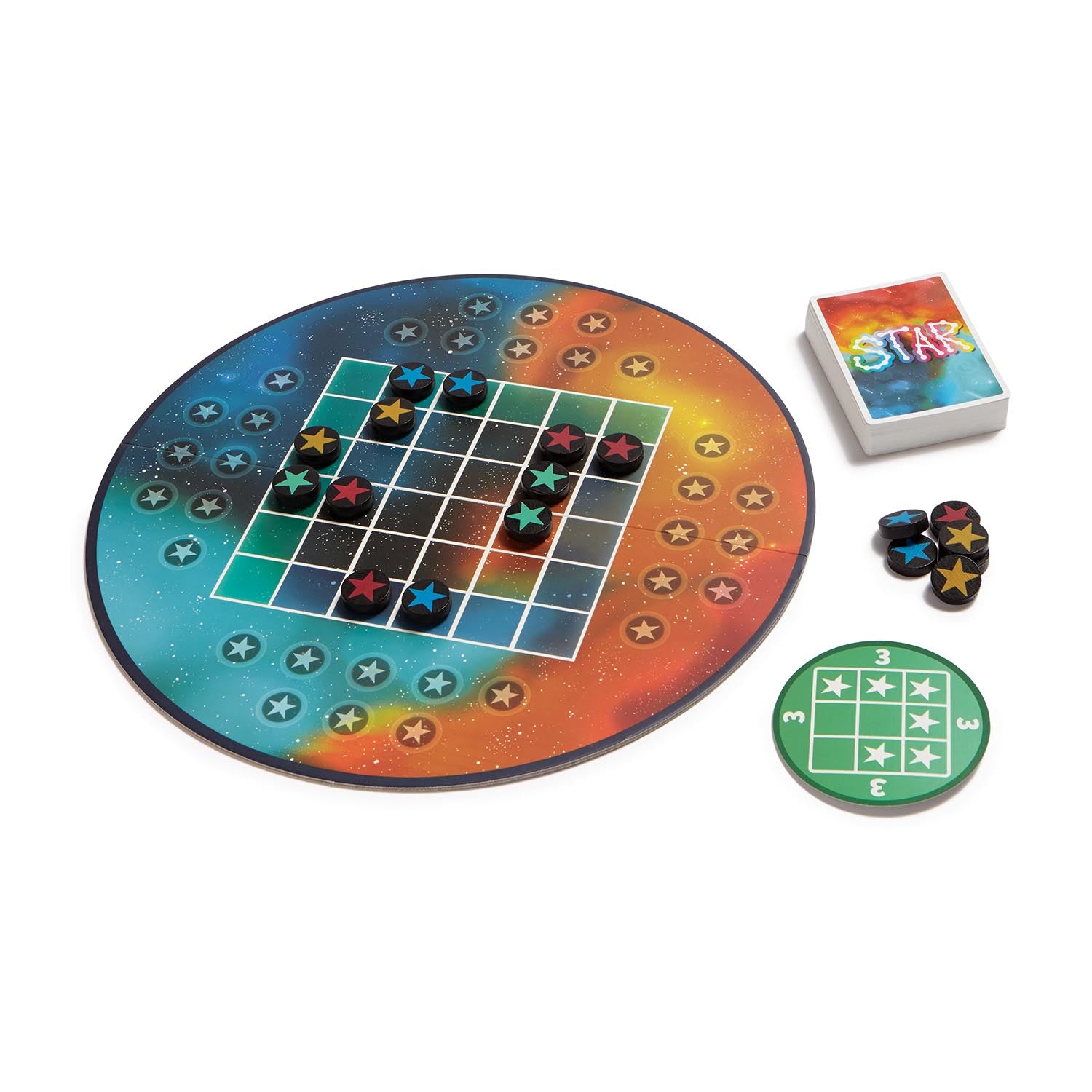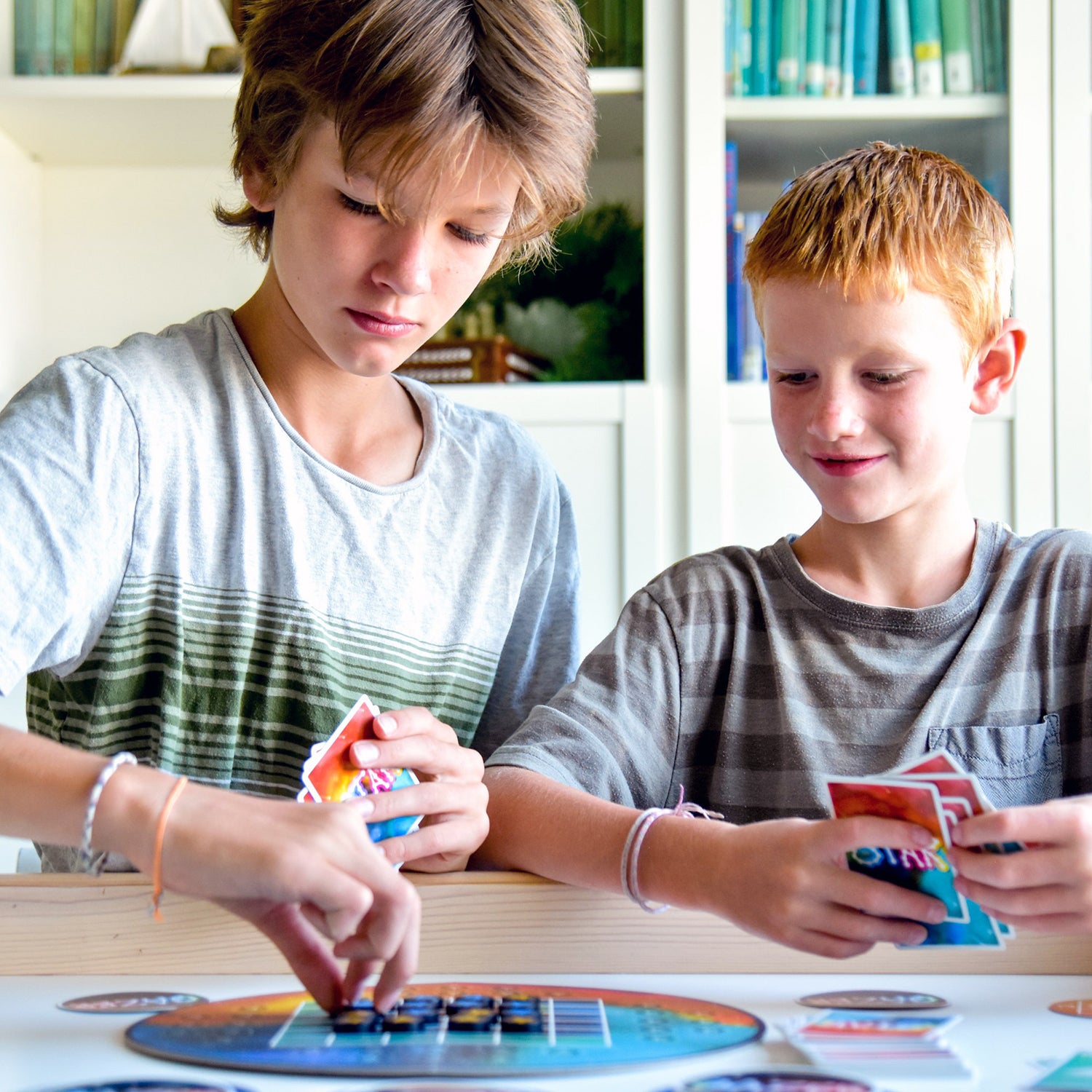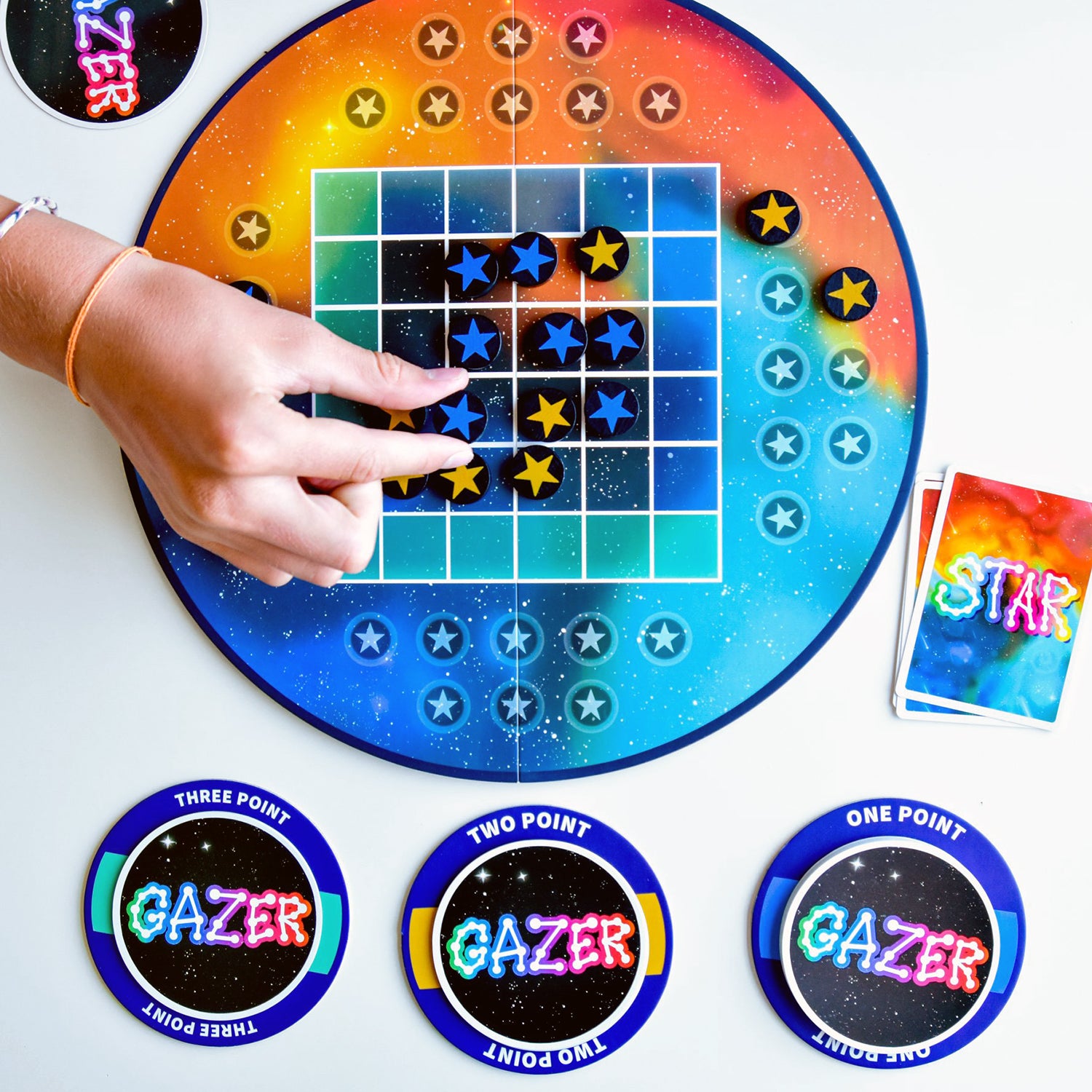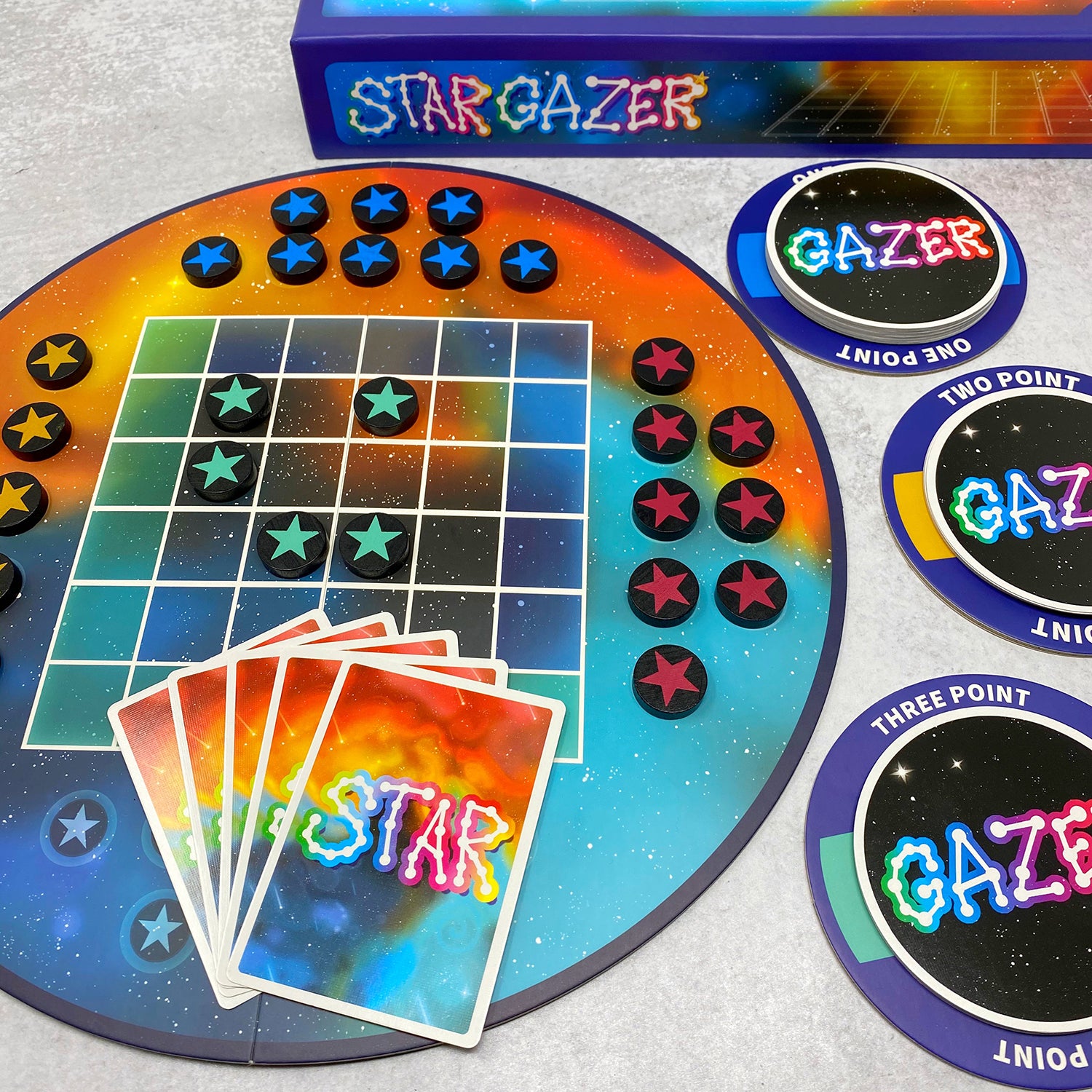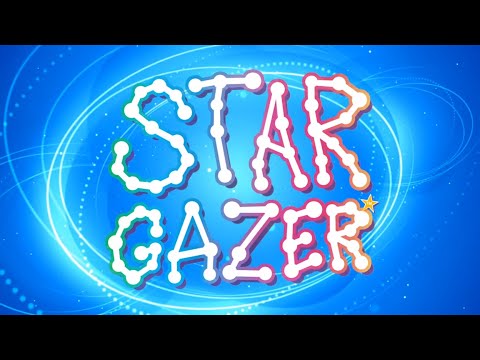Star Gazer
Star Gazer
2-4 players • 30 min • 10 & up
Focus: Strategy
Couldn't load pickup availability
Exercise strategy and spatial reasoning to be the best stargazer in the galaxy as you add, remove and swap star tokens to create stellar patterns.
Skills: Strategy, Spatial Reasoning, Patterning
Game Includes
Game Includes
- 1 Galaxy Board
- 32 Star Tokens (8 of each color)
- 54 Star Cards
- 45 Gazer Cards
- 3 Gazer Card Markers
- 1 Rules Booklet
Share
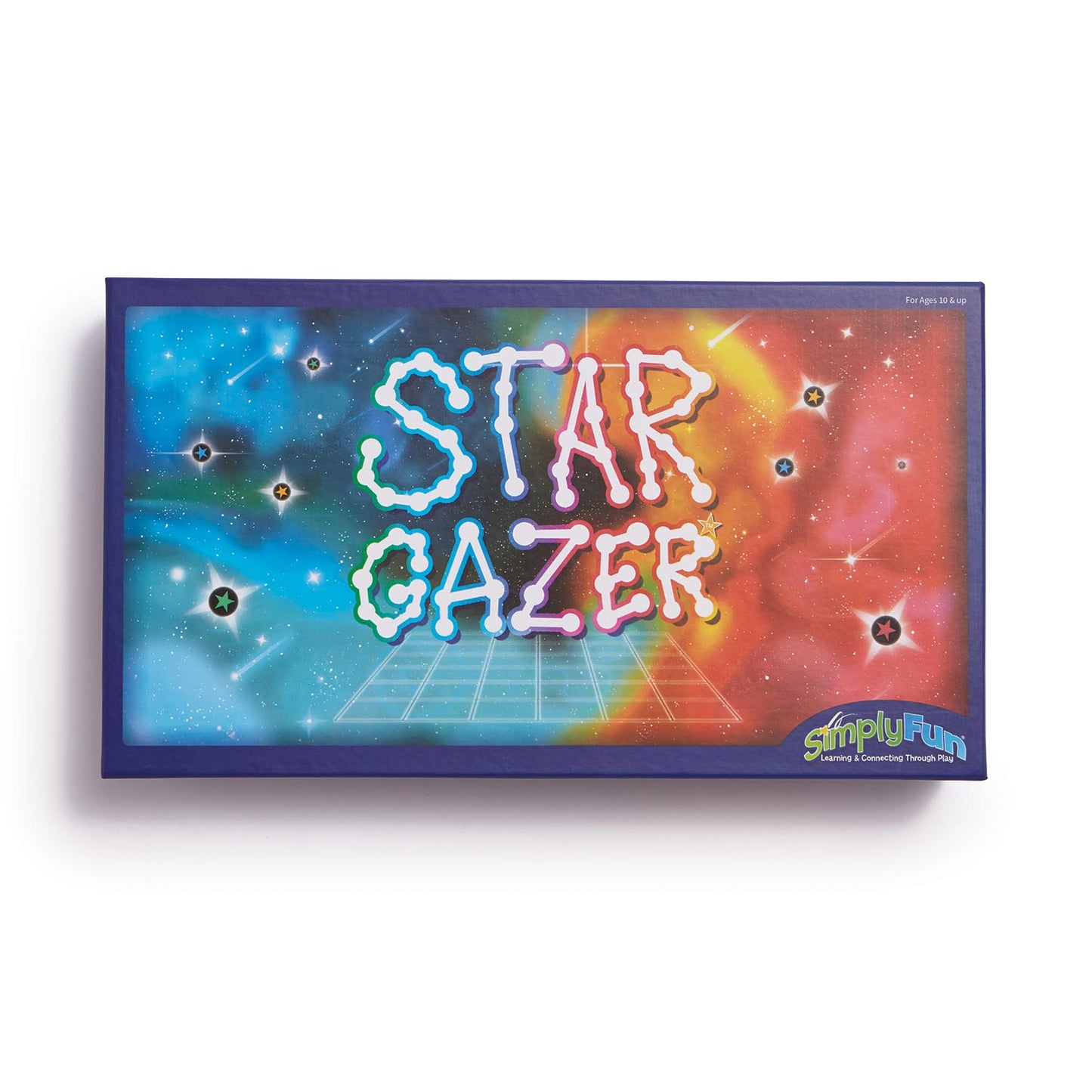
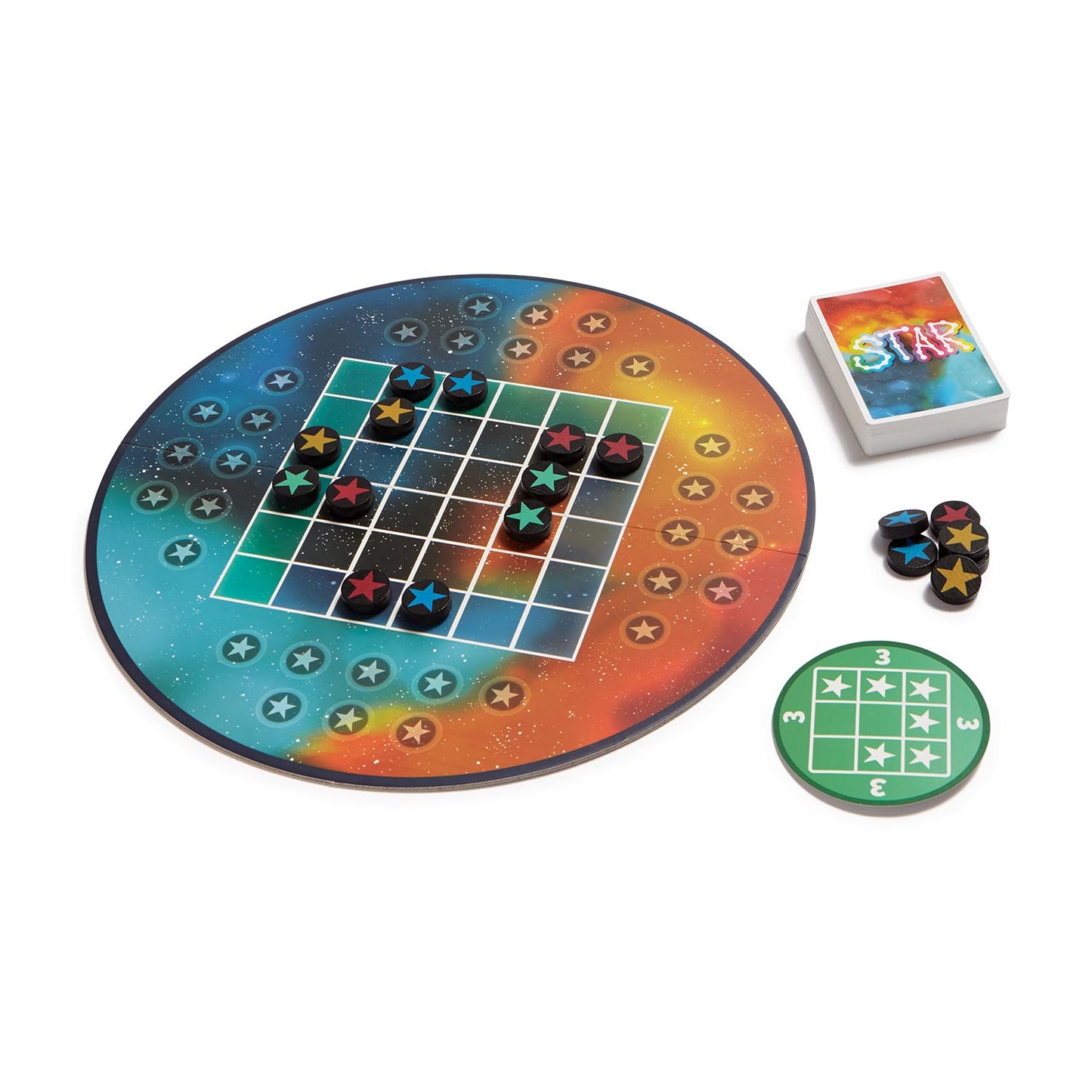
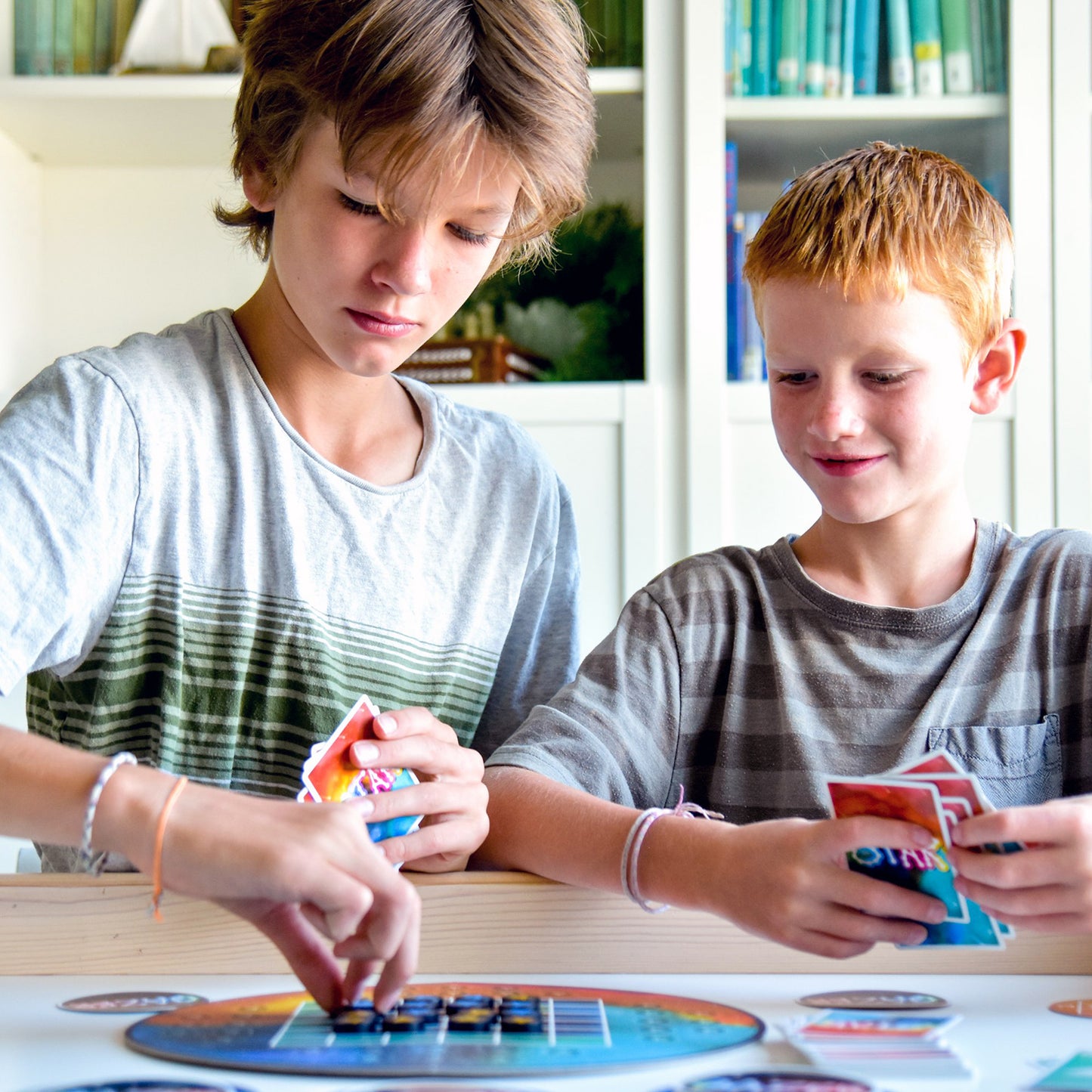
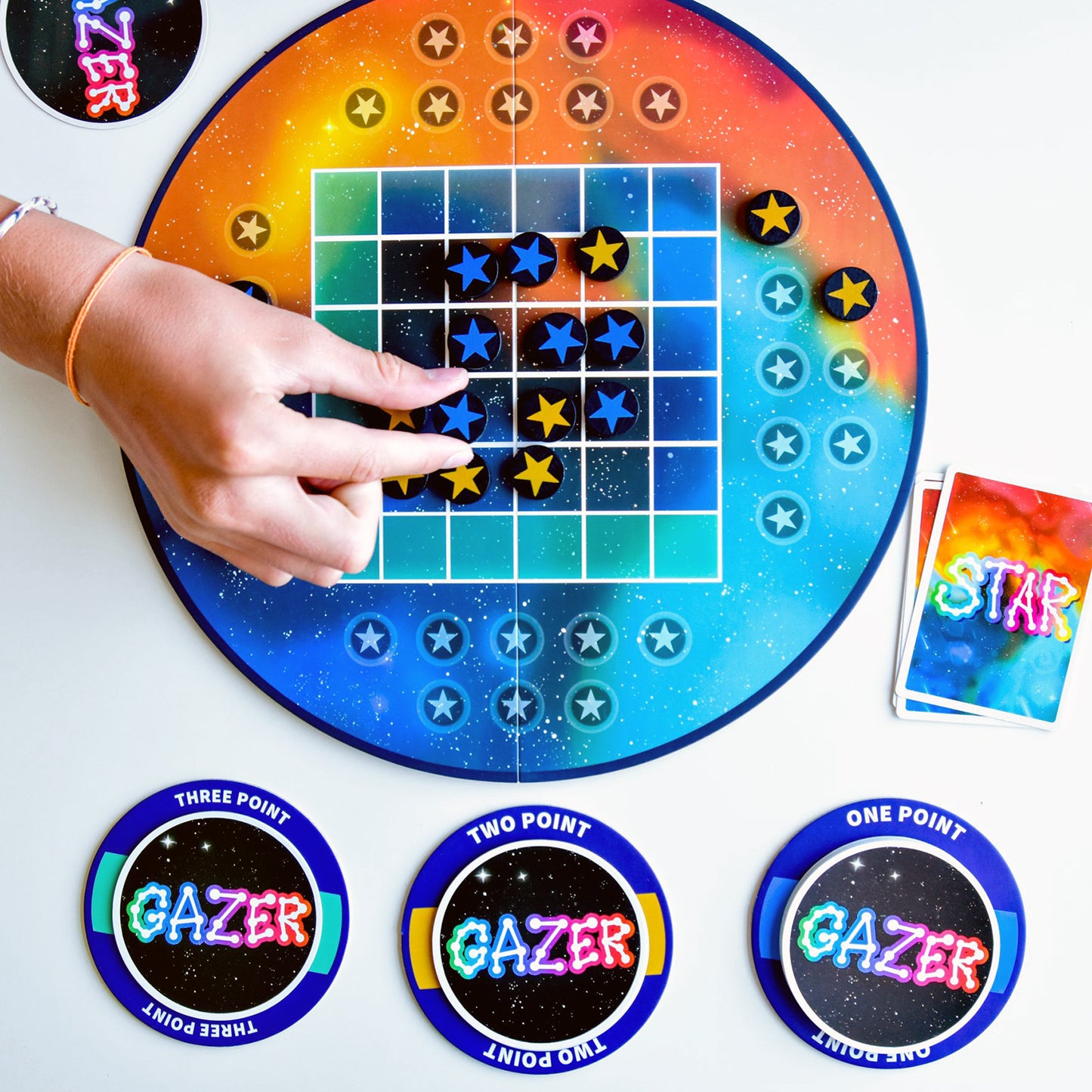
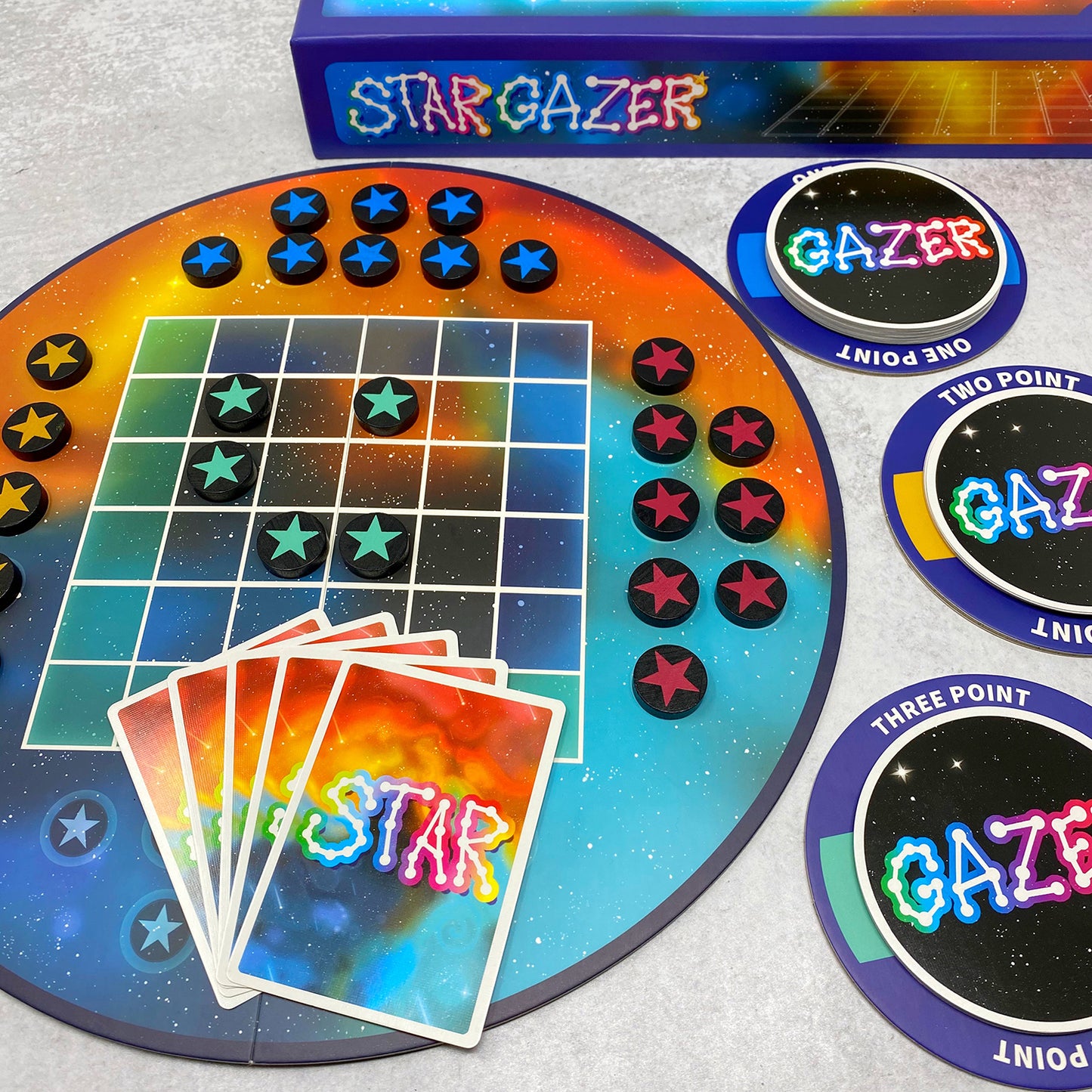
Collapsible content
How to Play
Educational Standards
Core Standard*: Math
- Math
- Generate and analyze patterns.: Grade Level 4th, 5th Standards for Mathematical Practice
- Look for and express regularity in repeated reasoning.: Grade Level 5th, 6th
- Look for and make use of structure.: Grade Level 5th, 6th
- Operations and Algebraic Thinking
Skills
Explore
What Does Child Do To Use Skill In The Game?
In Star Gazer, players explore the Star Tokens on the game board looking for which colors and patterns.
How Parents Can Assist Learning
There is no special parent support required. However, the longer the game goes on and the more Star Tokens on the board, parents can remind children to take their time to examine the board carefully for options.
Learning Implications and Educator Support
There is no special educator support required. However, the longer the game goes on and the more Star Tokens on the board, parents can remind children to take their time to examine the board carefully for options.
Determine
What Does Child Do To Use Skill In The Game?
Players need to determine which and how many of their cards to play or discard on their turn, and whether there is a matching pattern on the board to their Gazer Card.
How Parents Can Assist Learning
There is no special parent support required. However, you can remind children to look carefully at the board before deciding which card(s) to play. Ask them to ""Wait. Look. Think."" This will help with impulsivity, considering options and looking closely. Also, using such cues can give children a model for future play. Encourage children who are learning the game to tell you what they are thinking and show your their options. This is particularly important as the board gets more complicated. You may be able to assist them in seeing more options.
Learning Implications and Educator Support
Star Gazer is excellent for helping children develop pattern recognition, mental modelling and sequential thinking skills. There is no special educator support required. However, you can remind children to look carefully at the board before deciding which card(s) to play. Ask them to ""Wait. Look. Think."" This will help with impulsivity, considering options and looking closely. Also, using such cues can give children a model for future play. Encourage children who are learning the game to tell you what they are thinking and show your their options. This is particularly important as the board gets more complicated.
Compare
What Does Child Do To Use Skill In The Game?
Players need to compare the Star Tokens on the board with the pattern of the Star Gazer Card they are trying to match.
How Parents Can Assist Learning
Encourage children to hold their Star Gazer Card over the game board to more easily see patterns and potential matches. Also, show them how rotating their cards 90 and 180 degrees makes it easier to find pattern matches.
Learning Implications and Educator Support
Encourage children to hold their Star Gazer Card over the game board to more easily see patterns and potential matches. Also, show them how rotating their cards 90 and 180 degrees makes it easier to find pattern matches.
Predict
What Does Child Do To Use Skill In The Game?
Players may place or swap Star Tokens they expect to use in later turns, which requires anticipating what other players will do in response.
How Parents Can Assist Learning
To be successful in Star Gazer, children will greatly benefit if they pay close attention to the moves and scores of other players. Parents can help children practice predicting by asking questions like "why would you add, remove or swap a Star Token?" or "If you going to pick a Star Gazer Card, what point value card will you pick? Why would it be better or worse to pick a high number or a low number card?"
Learning Implications and Educator Support
Predicting involves skills like analysis, observation, empathy and interpretation. Educators can prompt children practice predicting by asking questions like "why would you add, remove or swap a Star Token?" or "If you going to pick a Star Gazer Card, what point value card will you pick? Why would it be better or worse to pick a high number or a low number card?"
Plan
What Does Child Do To Use Skill In The Game?
This is an essential skill of the game. Players need to look at their cards, Star Gazer card, Star Tokens on and off the board to think about and decide what move to make in order to make and match patterns. Players also need to make choices of lower or higher point value Star Gazer cards in an effort to have the most points at the end of the game.
How Parents Can Assist Learning
Remind children to look at the colors on top and on bottom of the pegs. Also, to help younger players, encourage them to hold the card over Star Tokens on the board to more easily see patterns and potential matches.. Additionally, as children become more advanced, they can become increasingly strategic by sequencing moves so that the Star Tokens they place on one turn can help them play another card in their hand on the next turn.
Learning Implications and Educator Support
Star Gazer is excellent for helping children develop pattern recognition, mental modelling and sequential thinking skills. On each turn, children will be looking at the Star Tokens on and off the board, as well as the cards in their hand, in order to decide on the sequence of cards to play. To help younger players, encourage them to hold their Star Gazer Card over tokens on the board to more easily see patterns and potential matches. Additionally, as children become more advanced, they can become increasingly strategic by sequencing moves so that the tokens they place or swap on one turn can help them achieve a pattern match on the next turn.
Practice
What Does Child Do To Use Skill In The Game?
Star Gazer allows players to practice their skills in pattern recognition, spatial thinking and strategy, similar to checkers or chess. The more you play, the better you'll be at this this game.
How Parents Can Assist Learning
Parents can encourage children to practice in order to master strategic elements of the game.
Learning Implications and Educator Support
Educators can encourage children to practice in order to master strategic elements of the game.
Solve
What Does Child Do To Use Skill In The Game?
As players place, remove and move Star Tokens, others are gathering information about what might match with their Star Gazer Card and what to do in future turns to make a match. Based on this, players decide which of their cards to play and which to discard.
How Parents Can Assist Learning
Parents can help children think about a strategy to begin the game, such as start by making 1 point patterns. However, as the game progresses, new information is being learned all the time which directly effects how players approach placing, swapping or removing Star Tokens. Children may need to adapt their strategy based on the actions and cumulative scores of other players. And, even on opponent's moves, they need to be looking for pattern matches. The ability to shift strategies based on new information can help children cope with the stresses of change in other areas of their life. If a child is falling behind opponents, discuss what their strategy is. For example, are they mostly trying to make 1 point Star Gazer Card patterns each turn in an effort to make more, lower scoring matches? If their strategy is not working, help them think about and try another approach.
Learning Implications and Educator Support
Educators can help children think about a strategy to begin the game, such as start by making 1 point patterns. However, as the game progresses, new information is being learned all the time which directly effects how players approach placing, swapping or removing Star Tokens. Children may need to adapt their strategy based on the actions and cumulative scores of other players. And, even on opponent's moves, they need to be looking for pattern matches. The ability to shift strategies based on new information can help children cope with the stresses of change in other areas of their life. If a child is falling behind opponents, discuss what their strategy is. For example, are they mostly trying to make 1 point Star Gazer Card patterns each turn in an effort to make more, lower scoring matches? If their strategy is not working, help them think about and try another approach.
Review
What Does Child Do To Use Skill In The Game?
Children may review if encouraged. See How Parents Can Assist Learning.
How Parents Can Assist Learning
For each pattern match, have the child hold the card near the Star Tokens and describe how the moves they made created the pattern or, if no move was needed, how they discovered the pattern. Reviewing helps embed strategies in the mind.
Learning Implications and Educator Support
For each pattern match, have the child hold the card near the Star Tokens and describe how the moves they made created the pattern or, if no move was needed, how they discovered the pattern. Reviewing helps embed strategies in the mind.
Demonstrate
What Does Child Do To Use Skill In The Game?
Children may demonstrate if encouraged. See How Parents Can Assist Learning.
How Parents Can Assist Learning
For each pattern match, have the child hold the card near the Star Tokens and describe how the moves they or other player's made created the pattern.
Learning Implications and Educator Support
For each pattern match, have the child hold the card near the Star Tokens and describe how the moves they or other player's made created the pattern.
*Data compiled from CCSSI ELA Standards, WA Science Standards, and Washington Social Studies Standards
Special Needs
Cognitive
Suggestions for How to Modify Play Experience
Star Gazer is a game of pattern development. It has levels of difficulty, so children with cognitive delays may be able to play the one-point patterns. Increase the difficulty as the child learns the game.
Begin by removing the swap a star and shooting star cards. This will introduce the simple elements of adding or removing a star to make a pattern. Once the child understands this process, add the shooting star cards. Finally, if the child can understand using other players stars, add the swap a star cards.
Communication
Suggestions for How to Modify Play Experience
Communication is not needed for the game, so Star Gazer is a good game for children with communication difficulties. Encourage commenting on plays whenever possible to promote social interaction.
Sensorimotor
Suggestions for How to Modify Play Experience
Star Gazer is not recommended for children with fine motor difficulties. The stars are small and require precise placement. Other players stars are easily shifted if care is not taken. For these reasons, the game will be difficult for children with fine motor concerns to play.
Social Emotional/Behavioral
Suggestions for How to Modify Play Experience
Star Gazer can be played at different levels of difficulty, making it a good game to build patience and self-control. Start with the One-Point Patterns. Children need to take time to study the board, their Gazer card, and the Star card. Encourage children to take their time to make the best decisions.
If the child becomes too frustrated, try playing in pairs, so that the child has support for ideas and patience.
Children with social-emotional and behavioral issues often have difficulty with reversal of fortunes. To help them learn to deal with this, start without the Shooting Star and Swap a Star cards. These cards allow players to remove another player's star, which can be frustrating for some children. Introduce the Shooting Star cards after the child understands the game, and finally add the Swap a Star cards. Support the child's feelings ("That was hard. He took off your star."), and encourage persistence ("Next time you can watch for your chance!")
Vision
Suggestions for How to Modify Play Experience
This game is not recommended for visually impaired. The green and blue stars are difficult to differentiate, the stars are small, and the board becomes increasingly complex as stars are added.
Hearing
Suggestions for How to Modify Play Experience
This game should not present a challenge for hearing impaired children. Play can proceed without discussion, if players do not know sign language or the hearing impaired player cannot read lips.
*Data compiled from CCSSI ELA Standards, WA Science Standards, and Washington Social Studies Standards
Autism
Autism Strengths & Interests
Short Summary of Strengths & Interests
- Can create matching patterns.
- Is good at spatial reasoning.
- Can plan a sequence of strategic moves.
Is good at matching visual items
Is This Game Appropriate? Yes
Description
Star Gazer is a great game for children who have a strength in visual matching and pattern development. Children with autism often are good at seeing details and finding a match. This game enables children to make picture-object matches at their chosen level of difficulty as they try to find an arrangement of Star Token that matches a pattern on one of their Gazer Cards.
Has a good memory for sensory details, including visual, touch, taste and smell
This game is not appropriate
Has a good memory for words, phrases and dialouge
This game is not appropriate
Has a good memory for pictures, numbers and patterns
This game is not appropriate
Likes to put things in order or a sequence
Is This Game Appropriate? Yes
Description
Like checkers or chess, the more you play Star Gazer the more easily you can see the patterns that the Star Tokens can make.Children who are good a recognizing and creating patterns will like Star Gazer as they hone their pattern making skills.
Learns through visualizing or "replaying" actions in their mind
Is This Game Appropriate? Yes
Description
In Star Gazer, players have cards with star patterns, and they try to match that pattern to Star Tokens on the game board. This includes adding, removing and moving tokens in order to make the match. Thus, children who enjoy activities involving making patterns will likely find Star Gazer a fun, engaging game. In addition, Star Gazer requires players to create a sequence of moves using their Star Cards in order to build a desired star pattern.
Likes activities with rules, such as math and phonics
Is This Game Appropriate? Yes
Description
If the children learn well by visualizing or replaying actions in their mind, they will likely enjoy using that ability in Star Gazer. Players use mental imagery to imagine what the board will look like when stars are added, taken away, switched in different ways.
Is very concrete and literal
This game is not appropriate
Learns in small "chunks" (for example, phone numbers are 3 chunks of number xxx-xxx-xxxx that are combined together)
Is This Game Appropriate? Yes
Description
Players move star pieces to make their pattern. This is a concrete process.
Is good at nonverbal reasoning and logic
This game is not appropriate
Likes spatial problem solving
Is This Game Appropriate? Yes
Description
Nonverbal reasoning is needed, but no direct communication is required, making Star Gazer a good game for children who have difficulty communicating what they are thinking. Players need good spatial reasoning skills in order to do well playing Star Gazer, but do not need to verbally explain their choices. Rather, they can demonstrate the accuracy of their thinking by showing their Gazer Card to the other players while pointing out the matching pattern on the game board. Additionally, players can make up to five moves in a turn. This requires players to think about what to do first, second, etc. in order to end up with the desired result on the board.
Can read well with good vocabulary, though may not fully comprehend content
Is This Game Appropriate? Yes
Description
Star Gazer is a great game for children who have a strength in spatial reasoning. Many children with autism are good at seeing and figuring out how objects are oriented in space. This game enables children to use this skill as they try to find an arrangement of Star Tokens that matches a pattern on their Gazer Card. Players can make up to five moves in a turn. They need to think about what stars to add, remove, and switch to create their pattern.
Likes to use and has good fine motor skill
This game is not appropriate
Likes established routines or set ways of doing things
Is This Game Appropriate? Yes
Description
Some children with autism like fine motor activities like playing with building toys and constructing puzzles. Star Gazer requires precise placement of small Star Tokens on the board.
Likes manipulating, constructing or building things
This game is not appropriate
Likes to use and has good musical abilities
Is This Game Appropriate? Yes
Description
Some children with autism like fine motor activities like playing with building toys and constructing puzzles. Star Gazer players manipulate small tokens to create their patterns on the game board grid.Thus, children with good dexterity will display their skills playing Star Gazer.
Likes to use and has good drawing skills
This game is not appropriate
Autism Special Considerations
Appears to ignore other's communication and/or has difficulty giving eye contact to a communication partner
Is This Game Appropriate for Child with Characteristic? Yes
Can Child with Characteristic Play Game w/o Modification? Yes
Strategies for Developing Compensatory Skills:
No eye contact or communication is needed to play the game.
Has difficulty understanding complex verbal directions
Is This Game Appropriate for Child with Characteristic? Yes
Can Child with Characteristic Play Game w/o Modification? No
Strategies for Developing Compensatory Skills:
As each player can play and/or discard up to five cards on each turn, play involves several steps and complex thinking. This may be difficult for some children with autism. Players with autism may require a partner or guidance to play the game.
Uses vocabulary inaccurately or demonstrates echolalia (repeating another's speech)
Is This Game Appropriate for Child with Characteristic? Yes
Can Child with Characteristic Play Game w/o Modification? Yes
Strategies for Developing Compensatory Skills:
The game is focused on reproduction of star patterns, so children's comments during the game do not necessarily influence play.If children's echolalia or comments are distracting, try to switch the child's thought patterns to the stars in the game.
Gets stuck repeating a verbal topic or physical actions and/or has difficulty attending to others' actions or topic.
Is This Game Appropriate for Child with Characteristic? Yes
Can Child with Characteristic Play Game w/o Modification? No
Strategies for Developing Compensatory Skills:
Players need to pay attention to the moves of other players, as these will influence their options for correctly completing their star pattern.If children cannot be easily redirected toward game play, this may be a difficult game for them to play. Although players can attend only to the board as it stands on their turn, they will do better if they watch the other player's moves in order to anticipate their own potential next moves.
Has difficulty producing speech/communication
Is This Game Appropriate for Child with Characteristic? No
Can Child with Characteristic Play Game w/o Modification? No
Strategies for Developing Compensatory Skills:
No discussion is needed to play the game
Has difficulty sequencing multi-step actions and/or doing complex abstract tasks
Is This Game Appropriate for Child with Characteristic? Yes
Can Child with Characteristic Play Game w/o Modification? No
Strategies for Developing Compensatory Skills:
There are up to five steps in each turn of play. This may be difficult for children with autism to organize and follow. In order to successfully play each turn in the game, players need to be able to visualize what will happen if a star is added or subtracted, another player's star is switched for one of his own, or a star is moved to another position. This requires ability to create mental imagery of what the board would look like if changes took place. This may be difficult for many children with autism except for those who enjoy pattern, strategy games like chess.
Demonstrates difficulty initiating and maintaining social interactions
Is This Game Appropriate for Child with Characteristic? Yes
Can Child with Characteristic Play Game w/o Modification? Yes
Strategies for Developing Compensatory Skills:
Social interaction is not required. Players can make their moves without discussion.
Acts out or demonstrates avoidance behaviors when frustrated, overwhelmed, or needs more sensory input.
Is This Game Appropriate for Child with Characteristic? Yes
Can Child with Characteristic Play Game w/o Modification? No
Strategies for Developing Compensatory Skills:
If the child needs to engage in a more sensorimotor activity, these can be built in after several rounds of play. Provide opportunities for gross motor movement (ex: do 5 jumping jacks between turns) and playing with preferred toys or objects.
Has short attention span for non-preferred activities
Is This Game Appropriate for Child with Characteristic? Yes
Can Child with Characteristic Play Game w/o Modification? No
Strategies for Developing Compensatory Skills:
If the child does not easily see patterns and like to create patterns, this game may not be preferred. Play as a partner with the child until the child understands and can create accurate patterns. Then see if the child can play independently.
Needs sameness or consistent routines and/or has difficulty with transitions from one activity to another
Is This Game Appropriate for Child with Characteristic? Yes
Can Child with Characteristic Play Game w/o Modification? No
Strategies for Developing Compensatory Skills:
There are many options that may occur with each turn. This may be frustrating for some children who need sameness. After the child plays the game numerous times, they will begin to anticipate the options and view them as routine. To help the child transition to the game, let them pick a Star Card to take to the game to play.
Has difficulty understanding others' feelings, intentions, and the reasons for others' actions.
Is This Game Appropriate for Child with Characteristic? Yes
Can Child with Characteristic Play Game w/o Modification? Yes
Strategies for Developing Compensatory Skills:
Players do not need to understand what others are thinking to play. Players do not know the pattern the other players are trying to create, so they play independently.
*Data compiled from CCSSI ELA Standards, WA Science Standards, and Washington Social Studies Standards
Extended Play
Extra Ways to Play the Game
Use the Star Tiles to do a constellation activity. From memory or content (such as a star chart), try to make real constellations. Then, challenge others to see if they can guess the constellation.
Materials Needed
Requires images and names of constellations from a source such as book or child safe internet site.
Developmental Benefits
This activity may spark interest in learning about astronomy. Additionally, children may learn about different mythologies that are the sources of constellation names.
Extra Ways to Play the Game
Play the game where the pattern you are trying to make is represented by the blanks spaces on a Star Card.
Materials Needed
No additional materials needed
Developmental Benefits
This makes the game easier, which can be helpful with learning or playing with younger children. It is easier because the matching the star pattern requires matching 2 criteria, the shape (star) and the color (red, blue, green or yellow). Using the blanks requires matching only one criteria, the empty space. Yet, both this version and the original version of the game allow children high levels of pattern making and spatial reasoning practice and development. Seeing "blank space" also requires children to shift their perspective in terms of focus of attention.
*Data compiled from CCSSI ELA Standards, WA Science Standards, and Washington Social Studies Standards
Collapsible content
How to Play Video & Transcript
Today, we’re going stargazing, and with a bit of strategy, you can be the master of the galaxy with Simply Fun’s Star Gazer.
To be a Star Gazer you should probably be aged 10 or older. You can play Star Gazer with 2 to 4 players.
Star Gazer allows players to practice their spatial reasoning and pattern recognition skills as they add, move and swap the stars to make specific stellar patterns. This kind of game play requires us to move objects in our mind as we visualize how to get to our desired result.
Inside the Star Gazer game box, you’ll find one round galaxy board for game play.
You’ll also find 32 Star tokens, 8 in each color: yellow, blue, green and red. Players will use Star tokens to create stellar patterns on the Gazer board.
There are 54 rectangular Star cards and 54 round Gazer cards. Gazer cards determine the stellar pattern a player must create, while Star cards are used to add, swap or remove Star tokens from the Galaxy board to create the stellar patterns.
Three Gazer card markers – each representing a different level of Gaze card difficulty – round out the contents.
To set up the game, place the Galaxy board where everyone can reach it.
If you’re playing with 2 players, use the 16 square grid – as shown. For 3 players, use the 25 square grid… And with 4 players, you’ll use the full board.
Now, hand out a set of 8 Star tokens to each player and ask the players to place them on their own side of the board. Like this.
Place the Gazer card markers to the side of the Galaxy board where everyone can reach them, and then deal stacks of Gazer cards face down onto the corresponding Gazer card markers. You’ll use a total of 25 Gazer cards per game. Place:
• 15 one-point cards on the one-point marker
• 5 two-point cards on the two-point marker, and
• 5 three-point cards on the three-point marker.
Put all remaining Gazer Cards back in the box.
Finally, shuffle the Star cards and the Gazer cards separately, and then deal each player FIVE Star cards and ONE 1-point Gazer card to begin with.
Place the remaining stack of Star cards in reach of all players so they can draw to replenish their hands at the end of each turn.
To begin play, the first player will attempt to complete the stellar pattern on his Gazer card. Blue Gazer cards are the least difficult and present one-point patterns, like this. Yellow Gazer cards are more difficult, and present two-point patterns, like this. Green Gazer cards are the most difficult. They present three-point patterns, like this.
The player’s objective is to arrange a single color of Star Tokens on the Gazer Board to form a pattern on one of the Gazer Cards they hold in their hand …from their perspective. To complete a pattern may take multiple turns as other players attempt to do the same thing with like Star Tokens from their perspective.
During each turn the player will try to complete the stellar pattern by performing five actions from the Star cards in his hand:
• With a yellow card, the player may add a star token to the Galaxy board.
• With a blue card he may remove a star token from the board.
• With a red card – a shooting star – he can either add or remove an opponent’s star token from the board.
• With a green card he may complete any one of three actions: 1) replace his opponent’s star token with one of his own, 2) move any star token on the board to another open space on the board, or 3) swap the position of any two star tokens on the board.
If a player competes the pattern on the Star card during his turn, he will place it on the discard pile. On any given turn, a player may choose to complete fewer than 5 actions or discard a Star card instead of playing it. Either way, each card added to the pile counts as one action.
Once a player has competed up to 5 actions OR completed the stellar pattern on his Gazer card, he will replenish his hand up to 5 cards and, if necessary, select a new Gazer card in the point value of his choice. Play continues with the next player, and rounds continue until one stack of Gazer cards is empty.
When a pattern on a Gazer card is complete on the Galaxy board, the player earns the point value – one, two or three points – on the card. BUT, the placement and orientation on the Galaxy board must match the Gazer card exactly AND all Star tokens used to create the pattern must be the same color.
Each player can only complete one stellar pattern per turn, and only earn points when the pattern is complete. Each player keeps their completed cards in a stack nearby to be counted at the end of the game.
Players can also earn points on an opponent’s turn: After another player has played at least one Star card on their turn, if a different player recognizes their own Gazer card pattern is complete on the board, they may reveal their card and claim the points. The Player will, however, have to wait until their turn to draw a new Gazer card.
The games ends when one player draws the last Gazer card in ANY ONE of the Gazer card stacks. The player who drew it takes his turn, and then each player takes one more turn until everyone has played.
All players then count the points in their personal Gazer card stacks and the player with the most points wins.
Count your lucky stars with Simply Fun’s Star Gazer!
- Choosing a selection results in a full page refresh.
- Opens in a new window.

